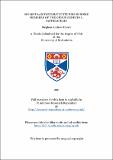Files in this item
Molecular systematic studies in some members of the genus Senecio L. (Asteraceae)
Item metadata
| dc.contributor.advisor | Ingram, Ruth | |
| dc.contributor.author | Harris, Stephen Andrew | |
| dc.coverage.spatial | 300 p. | en_US |
| dc.date.accessioned | 2018-06-15T14:12:35Z | |
| dc.date.available | 2018-06-15T14:12:35Z | |
| dc.date.issued | 1991 | |
| dc.identifier.uri | https://hdl.handle.net/10023/14128 | |
| dc.description.abstract | The large body of data which is available makes some members of the genus Senecio an ideal group on which to use molecular techniques to study biosystematic problems. Three major problems have been addressed:- (i) What is the degree of intraspecific DNA variation present in Senecio cambrensis, S. squalidus and S. vulgaris sl? (ii) Did S. vulgaris ssp. vulgaris var. hibernicus originate via the introgression of S. squalidus genes into S. vulgaris ssp. vulgaris var. vulgaris? (iii) Is S. cambrensis the allohexaploid hybrid of S. squalidus and S. vulgaris sl? These questions have been addressed using both the nuclear and chloroplast genomes. It has been demonstrated that molecular evidence can provide new insights into relationships, but can also produce results which are either contradictory to other evidence or inconclusive. Intraspecific variation was encountered in Senecio squalidus and S. vulgaris sl for both the nuclear (ribosomal DNA) and chloroplast genomes. This variation has provided new insights into the relationship between the two subspecies of S. vulgaris. It is proposed that S. vulgaris sl may have originated via reciprocal crosses between Senecio species possessing different chloroplast genomes. The hybrid nature of the majority of S. cambrensis populations was confirmed, since most of the Senecio species analysed could be distinguished on the basis of their ribosomal DNAs. Molecular techniques have produced contradictory evidence regarding the relationship of Senecio sgualidus to S. vulgaris ssp. vulgaris sl. In this case the two taxa have identical chloroplast genomes. This conflicts not only with the rDNA data but also with morphology, cytology and isozymes. The possible reasons for this conflict are discussed. The ribosomal and chloroplast genomes have produced inconclusive evidence regarding the introgressive origin of Senecio vulgaris ssp. vulgaris var. hibernicus. In this thesis some of the exciting applications of molecular biology to biosystematics have been reviewed and the need for multidisciplinary approaches to biosystematic problems is emphasised. | en_US |
| dc.language.iso | en | en_US |
| dc.publisher | University of St Andrews | |
| dc.subject.lcc | QK495.C74H2 | en |
| dc.title | Molecular systematic studies in some members of the genus Senecio L. (Asteraceae) | en_US |
| dc.type | Thesis | en_US |
| dc.contributor.sponsor | Natural Environment Research Council (NERC) | en_US |
| dc.type.qualificationlevel | Doctoral | en_US |
| dc.type.qualificationname | PhD Doctor of Philosophy | en_US |
| dc.publisher.institution | The University of St Andrews | en_US |
This item appears in the following Collection(s)
Items in the St Andrews Research Repository are protected by copyright, with all rights reserved, unless otherwise indicated.

